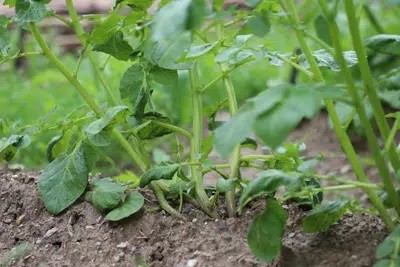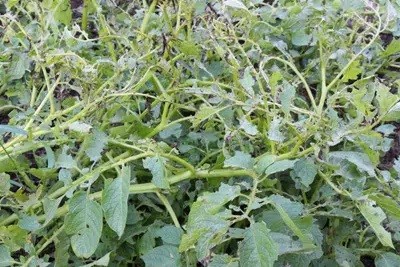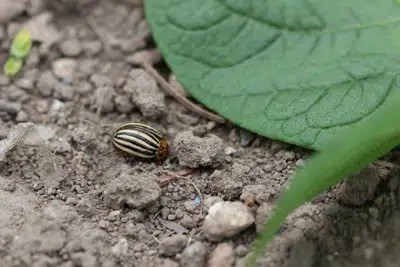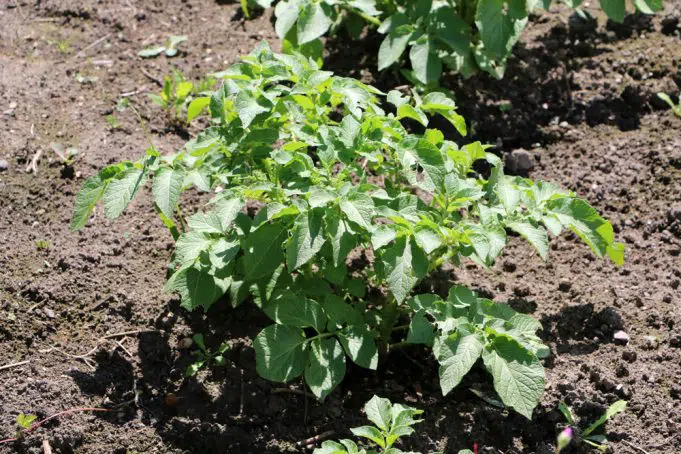Except for a few overbred potato varieties that do not flower, the flowering stage is part of the normal maturation process of the potato plant. After fertilization by insects, tomato-like fruits with seeds develop, but they are not used for horticultural and commercial potato cultivation. If the potatoes do not bloom, this may be due to various causes, ranging from care error to disease.
Contents
Flowering
With the help of special messenger substances in the leaves, potato plants are able to measure the length of the day. When certain conditions are reached, the plant begins to form flowers. By this time, many small tubers have already formed below the surface of the soil, but they still have to grow considerably in size over the next few weeks. The individual potato varieties differ significantly in their growth behavior. Early potatoes belong to the long-day plants, whose flowering is stimulated when the days become longer. Late-maturing varieties wait until fall, when days become shorter, to produce tubers and flowers.
- early potato varieties: ripening period 90 – 120 days, flowering period from the end of April to the beginning of June
- medium-early potato varieties: ripening period 120 – 150 days, flowering period from June onwards
- late potato varieties: ripening period 150 – 180 days, flowering period from the end of August onwards
Causes for the absence of flowering
Normally, flowering of the potato is a sure sign that in the soil the tubers also begin to grow. If potatoes do not bloom, this can have a variety of causes.
care mistakes

Potato plants are not particularly finicky in cultivation, but nevertheless unfavorable conditions can occur during cultivation. These care errors can also cause the failure to bloom.
Drought
Because of their limited root growth, potatoes depend on a steady supply of water. Insufficient water uptake, for example during prolonged drought, leads to an undersupply. Forgetting to water during this time not only prevents flowering, but risks killing the plant.
- Water regularly during dry periods
- especially shortly before and during the flowering period
- water as close to the ground as possible
Nutrient deficiency
Potatoes are heavy feeders and therefore need a soil with a high nutrient content. If this is too low, it does not matter much at the beginning of the growth phase. However, from the time shortly before the potato matures, it requires a great deal of strength and energy for tuber and flower formation. If there is a lack of nutrients, the plant is not able to form new plant tissue to an adequate extent and thus produce flowers and potato tubers.
- fertilize with manure in the fall before planting
- alternatively apply a green manure
- in spring work rotted compost into the soil
Tip: If sufficient fertilization has not been applied, you can top dress the plants with a complete fertilizer containing magnesium. However, avoid overfertilization when doing so
Unfavorable soil conditions
Potatoes prefer a loose, humusy and nutrient-rich garden soil that should be as free of weeds as possible. Those who have planted their seed potatoes in very heavy or sandy soils will be out of luck after the first growing season at the latest. Lack of water or waterlogging enormously inhibits the development of the potato plant, so that there may be difficulties in maturing. Improvement measures are hardly possible after planting.
- Carefully loosen the soil with a rake
- do not injure tubers and roots
- when mounding, work in compost
- possibly mix in sand
- keep weeds away at all costs
weather conditions
Potatoes thrive particularly well at temperatures between 18 and 25 degrees. Outside this comfort zone, the metabolism and growth of the plants change drastically. At temperatures above 30 degrees, the tubers will develop calyxes or chains. Depending on the seasonal temperature, flowering can then either occur significantly earlier or fail to occur at all.
ensure good ventilation
thin out the rows if necessary
possibly shade
diseases
In addition to a care error, a number of diseases can also be the cause that the potatoes do not want to bloom. Therefore, examine the plants regularly.
Late blight
Late blight is a disease caused by fungal pathogens. The fungus overwinters in potato tubers that have already been infected by the spores in spring or summer. From here, the fungus grows up the stem of the potato plant in the spring.
Damage
In humid weather, yellowish-green spots appear on the leaves, which soon turn dark. If the underside of the leaf is examined more closely, a whitish fungal turf can be seen at the boundary between dead and healthy tissue. In dry weather, the fungal turf disappears again. Infected potato tubers show irregular gray spots, which can also cover entire parts of the tuber. Under these spots, the tissue is discolored brown.
Measures
Systemic fungicides are available to control late blight, but they should not be used in home gardens. Remove the largest pockets of disease. Thinning of rows may be necessary to allow the potato haulm to dry out more quickly. Do not harvest potatoes until they already have firm skins. As of now, plant only resistant varieties.
Verticillium wilt
In dry, hot summers, wilt disease in potatoes causes high crop losses – and often also the failure of flowering. The pathogens are also fungi, which are widespread and occur almost everywhere.
Damage

What often appears to be harmless dry damage to the leaves of the potato plant can also be caused by a harmful fungus. In the plants, the leaves turn yellow from the tip. They curl, wilt and subsequently dry up. Usually, however, only individual shoots are affected. Since Verticillium wilt primarily affects fully developed plants shortly before flowering, the potato will then no longer flower.
Measures
The fungi cannot survive in the soil for very long, so judicious crop rotation is the best measure against the wilt disease. If the potato plants are nevertheless infested, individual, severely damaged plants can be taken out. In addition, careful weed control is important.
Tip: Targeted control measures against wilt disease are neither possible nor necessary
pests

In addition to the well-known Colorado potato beetle, which eats the leaves of the plant bare, other pests occur in potatoes. These can weaken the plant to the point that the flowers die or do not form at all.
- Colorado potato beetle and its larvae
- other pests: aphids such as the peach aphid, potato aphid or cruciferous aphid.
While potato beetles are best collected, against aphids various home remedies are suitable for injection. These include, for example, neem oil or even soapy water.
Conclusion
If potatoes do not bloom, there are a number of possible causes: Overcultivation, care errors, pests or even diseases. Although flowering is not essential for harvesting potatoes, the lack of flowering is often associated with insufficient tuber formation. Therefore, it is important to find out the reason and do something about the grievance.


